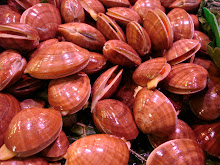They are willing to let me do any type of prep:
In my experience in the US, stages and low-level cooks prep almost entirely vegetables, sometimes helping out with meat, but only after it has been cut--seasoning, stuffing, etc. Here they are willing to let me try out anything myself, and so I’ve been breaking down piccione (squab) pretty often, and doing all the prep for it until it gets sent over to the stove for braising. They regularly break down a side of lamb during prep, and I want to do that one of these days, which I think will be possible, provided I ask.
Some really neat products:
On the subject of this lamb, the quality! According to Wikipedia, New Zealand lamb (and I think the US uses mostly that) has to be under 1 year old. The meat is definitely red, and the flavor has that distinct flavor that we associate with lamb. I think that the lamb we get here must be a few months younger than a year, because the meat is a very light pink, the flavor is extremely mild, and it is so much smaller. A lamb chop is about the same size as a silver dollar, and the rib bone which the chop attaches to is thinner than a pencil. While it is definitely a delicious product, I do miss that lamb flavor that you get with the older animals, but just like with suckling pig or any other very young meat, there is something exquisite about this.
The pigeons as well come a little differently than in the US. All that has been done to them is they’ve been plucked, and not well. So when prepping them it feels a lot more real, reminds you of exactly what you’re prepping. First I have to cut off their heads, claws, and wing tips, then burn away any feathers that might have been missed in the original plucking, then I cut off the tuchus of each bird so that I have access to the inner cavity of it. Next is the removal of all the giblets, and only at this point do I have a bird in my hands which resembles what you find for purchase in a US supermarket. It can get messy, but it is really gratifying. After all this, we finally break the birds down, removing the wings, separating the legs from the body, and filleting the breasts. The wings get stewed, the breasts get seared off, and the thighs get deboned and stuffed instead with a mixture of livers and hearts so that you have a little lollipop of meat on every drumstick.
Which brings me to another thing I like, which is that they have no fear of making a dish that takes up more time than any other. I think the pigeon is the most time-consuming dish to prepare (or maybe tied with the lamb), and that’s absolutely fine with everyone. I just above described all the work that goes into breaking down the birds--that takes me about an hour to do for eight birds, though I imagine I’ll get faster at it as I get more practice in--and then we cook them. The stew is what takes a long time, as we sear off the drumsticks and wings, then remove them from the cooking oil, drain that off, put the meat back in, do a wine reduction, add some broth, braise them until really tender, and then add a half-dozen different ingredients in. Its very different from some of our other braises, which are really just sear and stew kinds of processes.
 I like how we make all of our breads in-house. (this picture is actually from an outing we had for class, not from the restaurant. But doesn't it look yummy?)
I like how we make all of our breads in-house. (this picture is actually from an outing we had for class, not from the restaurant. But doesn't it look yummy?)I like how much the waiters love my American plating styles for the desserts.
I like how I’m starting to get to know the kitchen such that I can just see what is out on the counter and know what needs to be prepped by me.
I like how when I suggest an idea on a dish people listen to me and take my opinion seriously, even if they don’t ever follow it. Usually it has to do with salt levels. I like things slightly less salty than they do.
I like how Keiji will correct me. Instead of saying that I’m not doing something right, he’ll come over and say: “Leave more skin on the breast, its the most important part for searing, and you’re cutting off too much there.” Whenever he corrects me I feel like I learned something and I get a better understanding of a dish.
I like having a coffee at the beginning of every shift and a glass of wine at the end. I really like that to be honest. And the wines are usually great. It has been a great way for me to learn more about Tuscan wines, because I think we drink almost all Chianti wines, and comparing them to one another has helped me understand quite a lot more about the genre.
It can be hard in a restaurant setting to get overwhelmed by the negatives and the little things which are done every day, and in exchange lose the big picture. I think it requires conscious effort to maintain a positive outlook and not get bogged down with chopping parsley, but if you lose that big picture then the work becomes less valuable and you start to wonder what you’re doing there. Even with this short a time I’ve had those moments, and I just need to keep reminding myself why I’m there and thinking about all the great things I’m exposing myself to.





beautiful, jen!
ReplyDelete